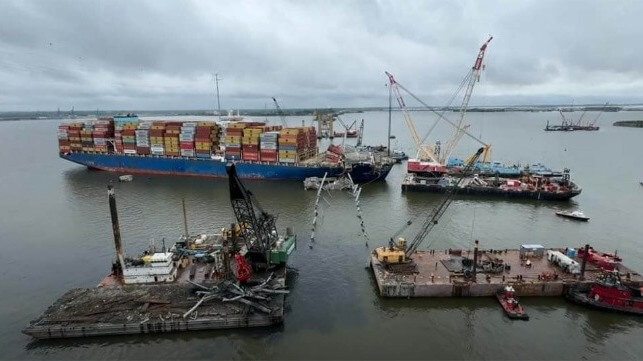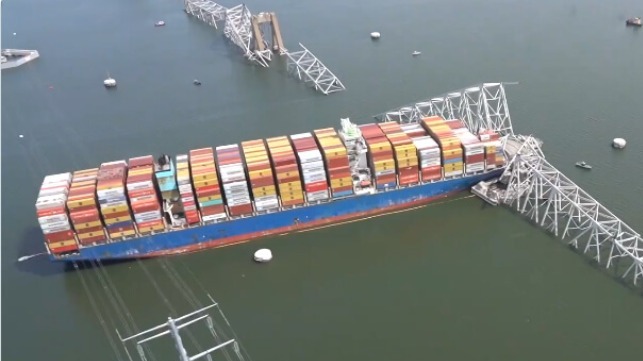Video: Wreckage Removal as Dali Refloating Awaits Dive Survey

The removal of the containership Dali from Baltimore’s Fort McHenry Federal Channel remains in flux according to a report in the Baltimore Sun. The Unified Command reports they are awaiting the results of a dive survey but in the meantime, wreckage clearance is continuing and a large part of the port is reopened to traffic.
The goal had been to refloat and move the containership early in the week after the controlled demolition of the wreckage sitting against the bow was completed. First, the demolition was delayed for 48 hours till Monday due to weather concerns. Now they are waiting for a survey of the wreckage and the underwater areas around the vessel after the demolition to plan the refloating. Dredging Contractors of America CEO Bill Doyle also previously said they had dredges standing by to assist as needed in the refloating process.
The Unified Command in its update on Thursday said it had evaluated sonar and lidar imagery from around the vessel. They were awaiting the dive survey before proceeding with the refloating plan. The diving was proceeding slowly due to the dangers and conditions in the Patapsco River.
“To permit safe diver access to the Patapsco riverbed next to the vessel, Unified Command cranes must first remove submerged and unstable wreckage from the controlled demolition,” they reported. “Safety also dictates the securing or removal of severely damaged containers and overhanging wreckage from the initial bridge collapse onto the deck of the M/V Dali.”
The target for the refloating is currently about a week behind the previous schedule. Officials said during the hearings this week in Washington D.C. that they expected to refloat the ship early next week. It will then be moved to the Seagirt Terminal in Baltimore. It will undergo further inspections, including a visit by the NTSB, and additional debris will be removed. The U.S. Coast Guard said they expect the vessel to remain at the terminal for four to six weeks and then likely shift to a shipyard for repairs.
Videos released by the command show new images aboard the vessel and the extent of the damage. It also shows the ongoing efforts to remove wreckage from the ship and the surrounding area. The Unified Command also highlights that clearance is ongoing in the central part of the Fort McHenry Channel.
Currently, nearly half the 700-foot-wide channel has been cleared to an operational depth of 48 feet. While access remains restricted, this means the port has been able to expand operations. To date, officials report more than 365 vessels have transited the four Port of Baltimore temporary alternate channels.
The two large bulkers that had remained trapped have both departed the port while inbound traffic is resuming. Yesterday, Wallenius Wilhelmsen’s first car carrier, Tannhauser (24,155 dwt) returned to the port for an overnight operation to offload. She departed today, May 17.
Port officials also highlighted the first RoRo cargo ship back into Baltimore. ACL’s Atlantic Sun (55,547 dwt) made her port call. She departed on May 15 for Halifax. Earlier in the week, the port also received another containership, MSC Shanghai V (66,685 dwt / 4,800 TEU). She departed on May 15 for Savannah. Maersk also announced that it is resuming bookings for Baltimore.
Next up is the return of the cruise ships. Today, Carnival Cruise Line confirmed its ship Carnival Pride (88,500 gross tons) will make her final departure from Norfolk this weekend and she will return to Baltimore for the first time on May 26. The ship’s next sailing, a 14-day cruise to Greenland, is scheduled to sail on May 26 and is expected to operate round-trip from Baltimore. Royal Caribbean International’s Vision of the Seas (78,491 GT) is scheduled to make a five-night round trip from Baltimore on May 26 to Bermuda.
The full restoration of the 50-foot channel remains dependent on the removal of the Dali. Officials remain confident that they will have the channel fully operational by the end of the month.
Congressman Pushes NTSB to Check Dali's Systems for Cyber Threats

In a hearing of the House Transportation Committee on Thursday, Congressman Brandon Williams (R-NY) pressed the National Transportation Safety Board to tear down and examine every component of the boxship Dali's electrical switchboards for signs of malicious code.
Working with Hyundai, which built the Dali, NTSB's investigators have determined that the ship lost electrical power because two main breakers tripped. Her generators kept running, but were no longer connected to the electrical bus that powers all critical systems. Soon after the crew restored the connection, two other breakers tripped. Without electrical power, the main engine's lube and coolant pumps turned off, and the engine automatically shut down to protect itself from imminent damage. This left Dali without propulsion as she approached - and then hit - Baltimore's Francis Scott Key Bridge. The resulting bridge collapse shut the port of Baltimore for weeks, and the roadway will not be restored for years; it is on track to become the most expensive maritime casualty claim on record.
These important findings rule out many other possible explanations for the casualty, like fuel contamination. However, the investigators still have to figure out why the breakers tripped at such an unlucky moment, and the answer is not immediately clear.
In questioning before the House Transportation Committee, Rep. Williams asked NTSB chair Jennifer Homendy just how deep her team planned to delve into the breaker system, and hinted at possible cybersecurity risks. Maritime cyber experts, the U.S. Coast Guard and the FBI have assessed that the odds of a cyberattack aboard Dali are low, and Homendy said that the investigation has seen no signs to suggest that there was any cyber intrusion. Rep. Williams - a former U.S. Navy nuclear submarine officer - urged Homendy to look deeper.
In a pointed exchange, Williams questioned whether NTSB has the capability to do a thorough component by component analysis of the entire switchboard control system, down to the most basic building blocks of its code. He raised the possibility that a sophisticated threat actor could target small, miniature computer assemblies - embedded systems - that control simple functions within the electrical system.
"There's a lot of concern about embedded systems, embedded into what is called a real-time operating system or inside the control logic or the control elements," he said. "That would require an enormous amount of forensics to evaluate . . . is that kind of investigation underway?"
Homendy said that her investigative team has 400 years of collective experience and will follow the evidence wherever it leads, adding that a cybersecurity threat would be in the jurisdiction of the Department of Justice. She noted that NTSB is required to notify law enforcement if it uncovers a possible crime or a cyberattack. "We will follow the evidence and anything security-wise, if we find anything, we will turn it over [to the FBI] immediately," she said.
The FBI has launched a parallel, court-authorized criminal investigation, and its agents boarded the vessel on April 15 to search it. The U.S. Coast Guard has also opened a Marine Board of Investigation - its most serious form of inquiry - to examine the causes of the casualty.
No comments:
Post a Comment